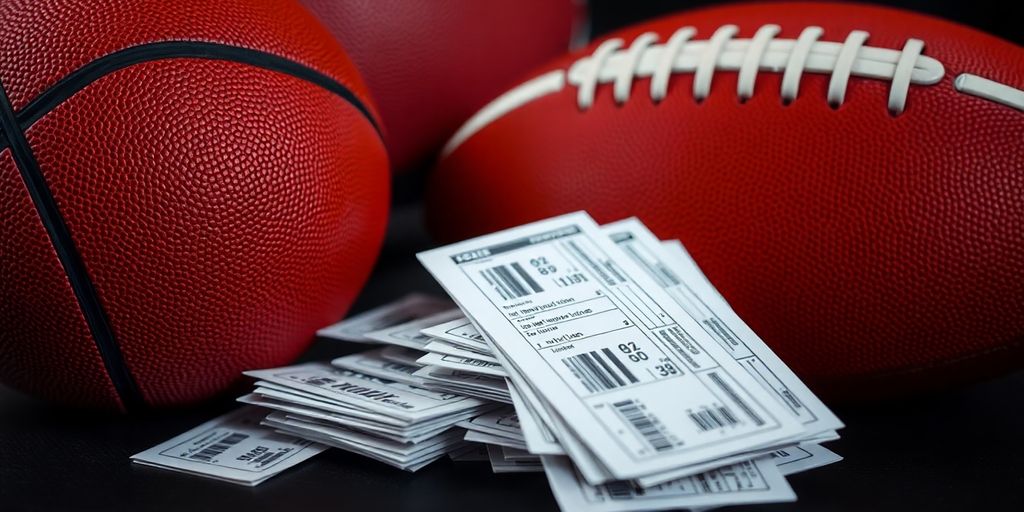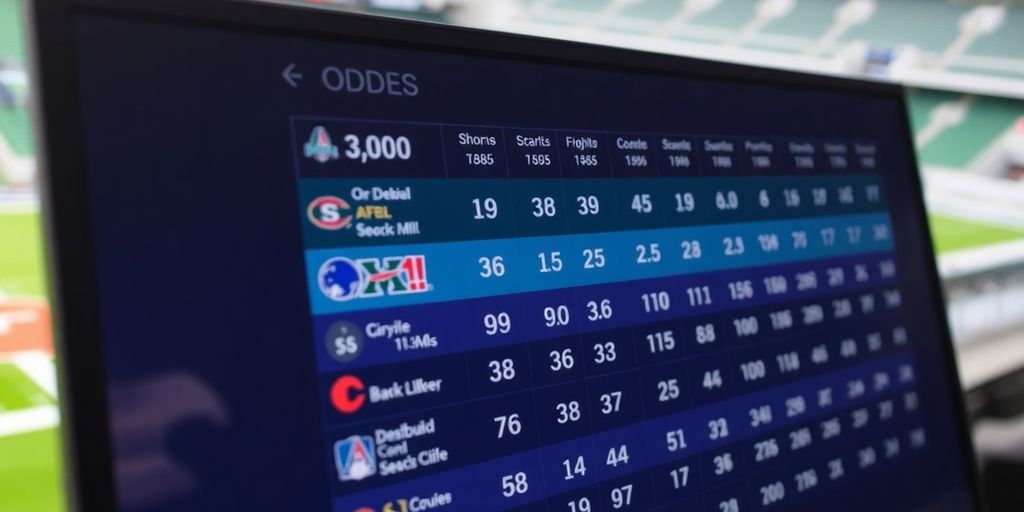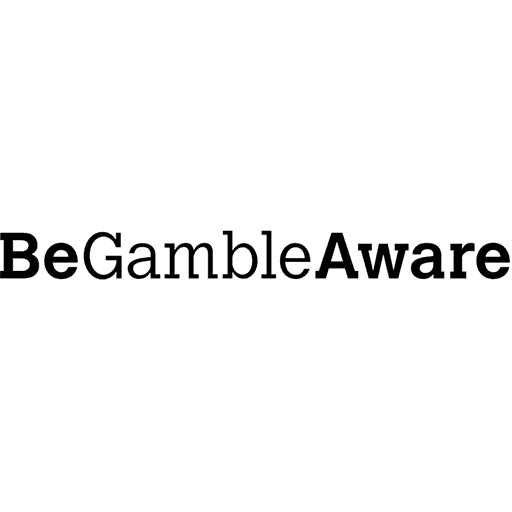Ever wondered how sports odds work? It can seem like a confusing mess of numbers at first glance. But really, it’s pretty simple once you get the hang of it. We’re going to break down how these numbers tell you about a game and what you could win. By the time we’re done, you’ll feel much more comfortable looking at those odds and making your own choices.
Key Takeaways
- Sports odds show you how likely something is to happen and how much money you can win.
- There are three main ways odds are shown: American, Decimal, and Fractional. They all say the same thing, just in different ways.
- Odds help you spot which team is expected to win (the favorite) and which is not (the underdog).
- Learning some basic terms, like “bankroll,” helps you bet smarter and keep your money safe.
- To bet like a pro, always compare odds, think about what’s going on in the game, and don’t let your feelings get in the way.
What Are Sports Betting Odds?
Defining Sports Odds
Sports betting odds are, at their core, a numerical representation of how likely a specific outcome is to occur in a sporting event. They also dictate how much money you stand to win if your bet is successful. Think of them as the language of sports betting; understanding this language is the first step to making informed decisions. They aren’t just random numbers; they’re carefully calculated estimations of probability, influenced by a multitude of factors like team performance, player injuries, and even weather conditions. Learning about hockey betting types is a great way to start.
Why Understanding Odds Matters
Why bother learning about odds? Well, imagine trying to drive a car without knowing how to read the speedometer or understand traffic signals. That’s what betting without understanding odds is like. It’s not just about knowing who’s likely to win; it’s about assessing the risk versus reward. Odds help you determine if a bet is worth making, regardless of how confident you are in the outcome. They allow you to compare different betting opportunities and identify situations where the potential payout outweighs the perceived risk. Plus, understanding odds is key to responsible bankroll management. It’s about making smart, calculated decisions, not just blindly throwing money at your favorite team. You can also find the best mobile betting apps to help you keep track of your bets.
Odds as Probability and Payout
Odds serve a dual purpose: they reflect the implied probability of an event happening and they determine the potential payout if your bet wins. Let’s break that down. Implied probability is the conversion of odds into a percentage chance of an outcome occurring. For example, if the odds suggest a team has a 50% chance of winning, you can use that information to evaluate whether the potential payout is worth the risk. The payout is simply the amount of money you receive if your bet is successful, including your original stake. Different types of odds (American, decimal, fractional) present this information in slightly different ways, but the underlying principle remains the same: odds are your guide to understanding both the likelihood and the potential reward of a bet. It’s important to understand sports betting odds before placing any bets.
Understanding the relationship between probability and payout is crucial. Lower odds mean a higher probability of winning, but a smaller payout. Higher odds mean a lower probability of winning, but a potentially larger payout. It’s all about finding the right balance between risk and reward that aligns with your betting strategy.
Understanding Different Types of Betting Odds
It’s easy to get lost when you first start looking at sports odds. There are different ways that sportsbooks show them, and it can be confusing. But don’t worry, it’s not as hard as it looks! The main thing to remember is that they all tell you the same thing: how likely something is to happen and how much money you could win. Let’s break down the three main types of odds you’ll see.
American Odds Explained
American odds are super common in the United States, so you’ll see them a lot. They look like this: +200 or -150. The plus and minus signs are important! The plus sign (+) tells you how much money you’d win if you bet $100. So, if you see +200, that means you’d win $200 on a $100 bet (and get your original $100 back, too). The minus sign (-) tells you how much you need to bet to win $100. So, if you see -150, you’d need to bet $150 to win $100 (plus get your $150 back).
Here’s a quick example:
| Odds | What it Means | Payout (on a $100 bet) |
|---|---|---|
| +150 | Win $150 for every $100 bet | $250 |
| -200 | Bet $200 to win $100 | $300 |
Decimal Odds Explained
Decimal odds are popular in Europe and Australia. They’re pretty simple to understand. They show you the total amount you’ll get back for every $1 you bet, including your original bet. So, if you see odds of 2.50, that means you’ll get $2.50 back for every $1 you bet. To figure out your profit, you just subtract 1 from the decimal odds. So, in this case, your profit would be $1.50 for every $1 you bet. If you’re into online soccer betting, you’ll see these a lot.
Fractional Odds Explained
Fractional odds are mainly used in the UK and Ireland. They look like fractions, like 5/1 or 7/2. The first number (the numerator) tells you how much profit you’ll make for every second number (the denominator) you bet. So, if you see odds of 5/1, that means you’ll win $5 for every $1 you bet (plus get your $1 back).
It might seem like a lot to take in at first, but once you get the hang of it, it becomes second nature. The important thing is to understand what the odds are telling you so you can make smart betting decisions. Don’t be afraid to take your time and practice converting between the different types of odds. There are plenty of online tools that can help you with this. Soon, you’ll be interpreting odds like a pro!
Here’s a quick rundown:
- Fractional: Common in the UK, shows profit relative to stake (e.g., 5/1 means you win $5 profit for every $1 staked).
- Decimal: Popular in Europe, represents total payout per $1 stake (e.g., 2.00 means $2 payout for every $1 staked).
- American: Used in the US, indicates profit on a $100 bet (positive) or stake needed to win $100 (negative).
How Sports Odds Work in Practice
Identifying Favorites and Underdogs
Okay, so you’re staring at some odds. How do you even know who’s supposed to win? Well, it depends on the type of odds. With American odds, the favorite has a minus (-) sign, and the underdog has a plus (+) sign. Decimal odds are pretty straightforward; the lower the number, the higher the probability of winning, making them the favorite. Fractional odds show the potential profit relative to your stake; the smaller the fraction, the more favored the team. Basically, sportsbooks use these numbers to tell you who they think will win.
Calculating Potential Payouts
Alright, let’s talk money. How do you figure out how much you’ll win? Again, it depends on the odds format. For American odds, if you see +200, a $100 bet wins you $200 (plus your original $100 back). If you see -200, you need to bet $200 to win $100. With decimal odds, you just multiply your stake by the decimal. So, a $10 bet at 2.5 odds returns $25 (your $10 stake plus $15 profit). Fractional odds are similar; if the odds are 3/1, you win $3 for every $1 you bet. A $10 bet gets you $30 in profit, plus your $10 back. Understanding betting odds is key to making smart choices.
The Role of the Sportsbook
Sportsbooks aren’t just neutral scorekeepers; they’re in the business of making money. They set the odds, but not necessarily based on who will win. They set them to balance the action – to get roughly the same amount of money bet on both sides. This way, they make their profit from the vigorish (or "vig"), which is essentially a commission on every bet. So, the odds reflect not just the probability of an event, but also public perception and betting trends. It’s a market, just like the stock market, but with Canadian sportsbooks instead of stocks.
Sportsbooks use sophisticated algorithms and expert analysis to set initial odds. However, these odds are constantly adjusted based on betting activity, news, and other factors. This dynamic nature of odds is what creates opportunities for savvy bettors who can identify discrepancies and value bets.
Key Terminology in Sports Betting
Understanding Wagers and Payouts
Okay, so you’re ready to place a bet. First, you gotta know what you’re actually doing. A wager is simply the money you risk on a specific outcome. The payout is what you get back if you win, including your original stake plus the profit. It’s pretty straightforward, but understanding the relationship between the wager, the odds, and the potential payout is key. For example, a $10 wager at +200 odds will net you $20 in profit, plus your original $10 back, for a total payout of $30.
Bankroll Management Basics
Bankroll management is super important. Think of your bankroll as your betting budget. It’s the total amount of money you’ve set aside specifically for betting, and you should never bet more than you can afford to lose. Seriously. Here are some basic tips:
- Set a budget: Decide how much you’re comfortable losing each month or week and stick to it.
- Track your bets: Keep a record of your wagers, wins, and losses to see where your money is going. This helps you identify leaks and adjust your strategy.
- Avoid chasing losses: Don’t try to win back lost money by placing bigger or riskier bets. This is a recipe for disaster. It’s better to cut your losses and come back another day. Consider using deposit limits to help you stay in control.
Treat your bankroll like a business. You wouldn’t throw money away in a business, so don’t do it with your betting funds. Proper management is the difference between a fun hobby and a financial problem.
Common Betting Terms
Here’s a quick rundown of some terms you’ll hear a lot:
- Favorite: The team or player expected to win. They usually have negative odds in American format.
- Underdog: The team or player expected to lose. They usually have positive odds.
- Spread: A point handicap used to even the playing field between two unevenly matched teams. You can find point spreads at most sportsbooks.
- Moneyline: A straight bet on who will win the game, regardless of the score. It’s a simple way to get started with moneyline betting.
- Over/Under (Totals): A bet on whether the total combined score of a game will be over or under a specific number set by the sportsbook.
- Prop Bet: A bet on something other than the final outcome of a game, like a player’s performance or a specific event during the game. Some sportsbooks offer sports betting bonuses that can be used on prop bets.
- Parlay: A single bet that combines multiple selections. All selections must be correct for the parlay to win, but the payout is significantly higher. Be careful with these!
Interpreting Odds Like a Professional
Comparing Odds Across Sportsbooks
Okay, so you want to read odds like a pro? First thing’s first: don’t just settle for the first odds you see. Different sportsbooks will offer slightly different odds on the same event, and those little differences can really add up over time. Shopping around is key. It’s like finding the best deal on anything else – you wouldn’t buy the first TV you see, right? Think of it as maximizing your potential return.
- Check multiple sportsbooks.
- Look for discrepancies.
- Consider using an odds comparison tool.
Considering Contextual Factors
Odds aren’t just numbers pulled out of thin air. They reflect a whole bunch of factors that can influence the outcome of a game. Things like injuries, weather, team morale, and even travel schedules can all play a role. Ignoring these factors is like trying to bake a cake without a recipe – you might get lucky, but probably not. For example, Oilers’ odds can be affected by player injuries.
It’s easy to get caught up in the numbers, but remember that sports are unpredictable. Contextual factors can shift the odds in unexpected ways, so always do your homework.
Analyzing Market Perceptions
Odds also reflect what other bettors think is going to happen. If a lot of people are betting on one team, the odds for that team will probably get shorter, and the odds for the other team will get longer. This doesn’t necessarily mean that the popular team is more likely to win, but it does mean that the market thinks they are. Sometimes, going against the grain can be a smart move, especially if you think the market is overreacting. Understanding Bodog NHL betting odds involves recognizing market perceptions.
Here’s a simple way to think about it:
| Scenario | Market Perception | Potential Strategy |
|---|---|---|
| Heavy favorite | Overvalued | Consider betting against if you see a weakness. |
| Clear underdog | Undervalued | Evaluate if their chances are better than perceived. |
| Evenly matched | Balanced | Look for contextual factors to tip the scales. |
Making Informed Betting Decisions
Leveraging Historical Data
Looking at the past can really help you make smarter bets. Dig into team stats, player performance, and head-to-head records. See how teams do at home versus away, or how certain players perform against specific opponents. This kind of info can give you an edge. For example, if you’re into NFL online betting, check out how quarterbacks perform in different weather conditions – it can make a big difference!
Maintaining Betting Discipline
Betting discipline is super important. It’s easy to get carried away, especially after a win or a loss. Set clear rules for yourself and stick to them. This includes things like:
- Having a set budget and not going over it.
- Avoiding chasing losses by placing bigger bets to win back what you’ve lost.
- Sticking to your betting strategy, even when things aren’t going your way.
It’s easy to get caught up in the excitement, but remember that sports betting should be fun, not stressful. If you find yourself getting too emotional or spending more than you can afford, it’s time to take a break.
Avoiding Emotional Wagers
Don’t let your heart rule your head. It’s tempting to bet on your favorite team, but that can cloud your judgment. Stick to the data and the facts, and try to be objective. Sometimes, the smart bet is against the team you love. If you’re looking for betting insights, remember that logic trumps loyalty every time. Also, be sure to understand betting odds before placing any wagers.
Wrapping It Up
So, there you have it. We’ve gone over the basics of sports odds. It might seem like a lot at first, but once you get the hang of it, it’s pretty straightforward. Remember, odds are just numbers that tell you how likely something is to happen and what you could win. Knowing how to read them helps you make smarter choices. It’s not about being a math whiz; it’s about understanding the game a bit better. Keep practicing, and you’ll be looking at those odds like a pro in no time. Good luck out there!
Frequently Asked Questions
What are sports betting odds?
Sports betting odds are basically numbers that tell you two main things: how likely an event is to happen, and how much money you could win if you bet on it. They help you figure out if a bet is worth making.
What are the different types of odds?
There are three main kinds: American odds (common in the U.S., shown with + or – signs), Decimal odds (popular in Europe, simple numbers like 1.50), and Fractional odds (used a lot in the UK, like 3/1). Each one shows the same info but in a different way.
How do odds show favorites and underdogs?
Odds show you which team is expected to win (the “favorite”) and which is expected to lose (the “underdog”). Favorites usually have lower payouts because they’re more likely to win, while underdogs offer bigger payouts if they pull off a surprise.
What is a sportsbook’s role?
A sportsbook is like the company or website that takes your bets. They set the odds for different games, take your money when you bet, and pay you out if you win. They make sure everything runs smoothly.
What do “wager,” “payout,” and “bankroll” mean?
“Wager” just means the money you bet. “Payout” is the total amount of money you get back if your bet wins, which includes your original bet plus your winnings. “Bankroll” is the total amount of money you’ve set aside just for betting.
How can I make smarter betting decisions?
To bet smarter, always compare odds from different sportsbooks to get the best deal. Think about other things that might affect the game, like injuries or weather. Also, look at past games to see how teams have done before. And most importantly, don’t let your feelings guide your bets; stick to your plan.













